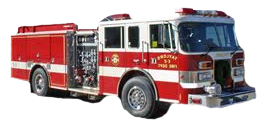Fire Prevention Week is October 3-9, 2021
Learn the Sounds of Fire Safety™
Smoke Alarm Safety:
 This year’s FPW campaign, “Learn the Sounds of Fire Safety!” works to educate everyone about the different sounds the smoke and carbon monoxide alarms make. Knowing what to do when an alarm sounds will keep you and your family safe. When an alarm makes noises – a beeping sound or a chirping sound – you must take action.
This year’s FPW campaign, “Learn the Sounds of Fire Safety!” works to educate everyone about the different sounds the smoke and carbon monoxide alarms make. Knowing what to do when an alarm sounds will keep you and your family safe. When an alarm makes noises – a beeping sound or a chirping sound – you must take action.
What if someone in my home is deaf or hard of hearing?
There are smoke alarms and alert devices that alert people who are deaf or hard of hearing. These devices include strobe lights that flash to alert people when the smoke alarm sounds. Pillow or bed shakers designed to work with your smoke alarm also can be purchased and installed. For more information on this important topic, visit Fire Safety for the deaf or hard of hearing section.
Frequently Asked Questions about smoke and carbon monoxide (CO) alarms
Carbon monoxide is an odorless, colorless gas that displaces oxygen in your body and brain and can render you unconscious before you even realize something is happening to you. Without vital oxygen, you are at risk of death from carbon monoxide poisoning in a short time. CO alarms detect the presence of carbon monoxide and alert you so you can get out, call 9-1-1, and let the professionals check your home.
How do I know which smoke and CO alarm to choose for my home?
Choose an alarm that is listed with a testing laboratory, meaning it has met certain standards for protection. Whether you select a unit that requires yearly changing of batteries, or a 10-year unit that you change out at the end of the 10 years, either will provide protection.
CO alarms also have a battery backup. Choose one that is listed with a testing laboratory. For the best protection, use combination smoke and carbon monoxide alarms that are interconnected throughout the home. These can be installed by a qualified electrician so that when one sounds, they all sound. This ensures you can hear the alarm no matter where in your home the alarm originates.
Importance of fire prevention
In a fire, mere seconds can mean the difference between a safe escape and a tragedy. Fire safety education isn’t just for school children. Teenagers, adults, and the elderly are also at risk in fires, making it important for every member of the community to take some time every October during Fire Prevention Week to make sure they understand how to stay safe in case of a fire.
On this site, you’ll find loads of educational resources to make sure that every person knows what to do in case of a fire. We have everything from apps to videos to printables and much more, to make sure you have the resources you need to keep your family, your community, and your city safe.
About Fire Prevention Week
Since 1922, the NFPA has sponsored the public observance of Fire Prevention Week. In 1925, President Calvin Coolidge proclaimed Fire Prevention Week a national observance, making it the longest-running public health observance in our country. During Fire Prevention Week, children, adults, and teachers learn how to stay safe in case of a fire. Firefighters provide lifesaving public education in an effort to drastically decrease casualties caused by fires.
Fire Prevention Week is observed each year during the week of October 9th in commemoration of the Great Chicago Fire, which began on October 8, 1871, and caused devastating damage. This horrific conflagration killed more than 250 people, left 100,000 homeless, destroyed more than 17,400 structures, and burned more than 2,000 acres of land.
Smoke Alarms
- Smoke alarms detect and alert people to a fire in the early stages. Smoke alarms can mean the difference between life and death in a fire.
- Working smoke alarms cut the risk of dying in a home fire in half.
- Install smoke alarms in every sleeping room, outside each separate sleeping area, and on every level of the home, including the basement.
- Test smoke alarms at least once a month using the test button.
- Make sure everyone in the home understands the sound of the smoke alarm and knows how to respond.
Home Fire Escape Planning
- Home fire escape planning and drills are an essential part of fire safety. A home fire escape plan needs to be developed and practiced before a fire strikes.
- A home escape plan should include the following:
- Two exits from every room in the home – usually a door and a window
- Properly installed and working smoke alarms
- A meeting place outside, in front of the home, where everyone will meet after they exit
- A call to 9-1-1 or the local emergency number from a cell phone or a neighbor’s phone
- Plan ahead for your escape. Make your home escape plan and practice today.
Fire Escape Plan Grid
Activities for Children
Sparky! Online Games and Activities
Beep activity page
Family-Fire-Safety-Activity
Beep-Beep-Beep Coloring Page
Family Home Action Plan
Fire Prevention Week Theme Safety Tip Sheet
Smoke Alarm Calendar
Smoke Alarm Hidden Picture Puzzle
Resources:




